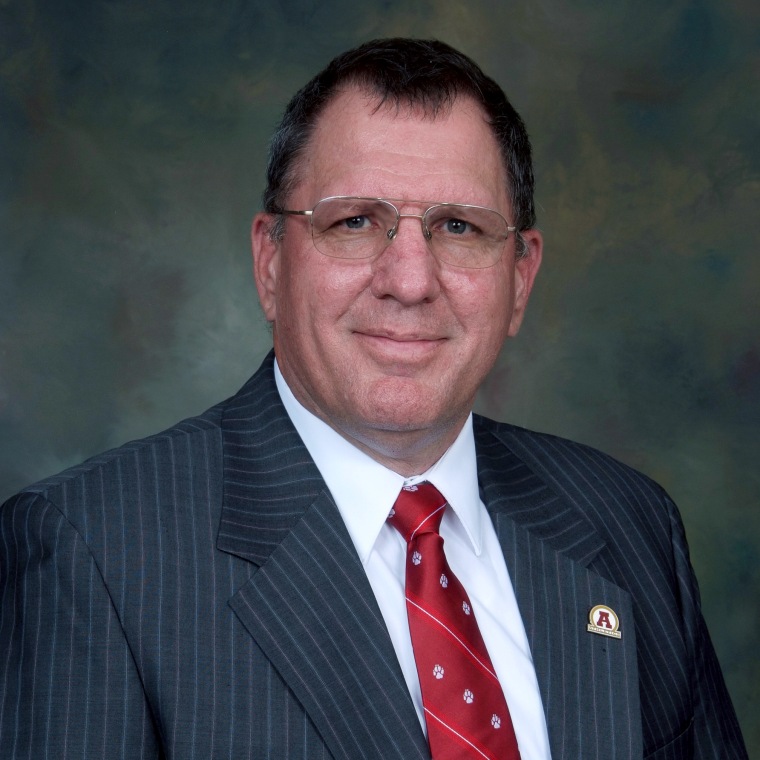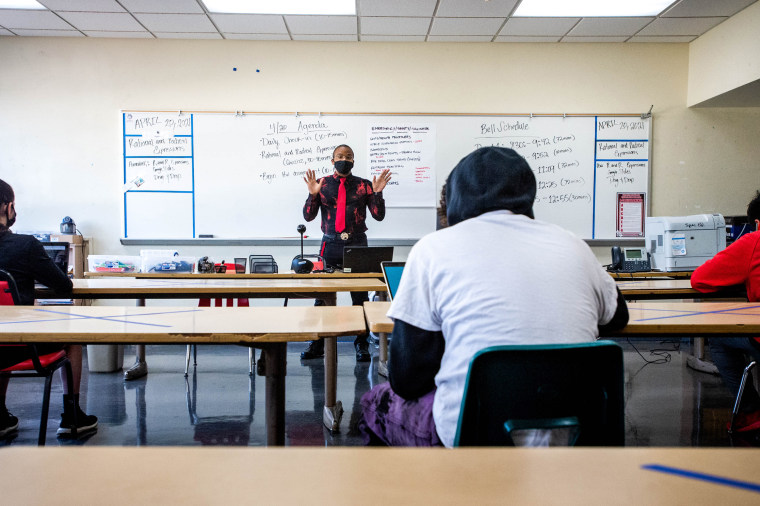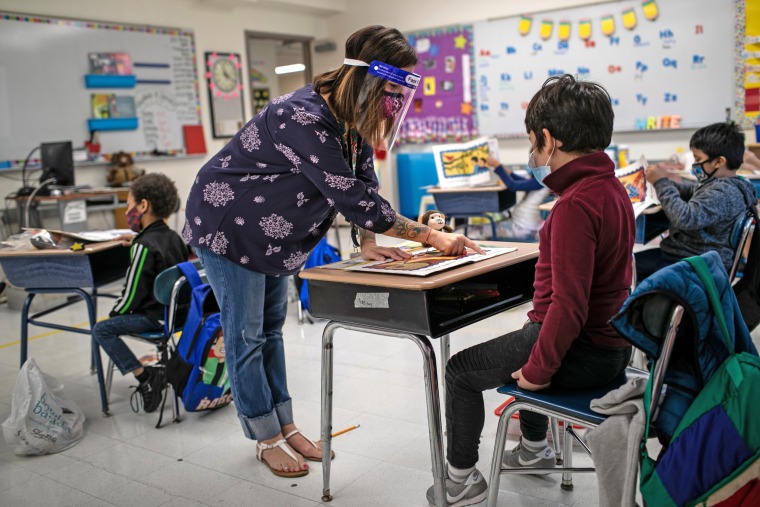It wasn't so long ago that Charles Prijatelj, the superintendent of the Altoona Area School District, was receiving up to 150 applications for elementary school teacher job openings.
In recent years, however, the number of applicants for each opening at his 7,400-student district in central Pennsylvania has dwindled to as little as three or four.
“There just aren't enough teachers. There isn't a big pool to pull from. Retirements are through the roof and people are leaving the profession even more than they were due to all the havoc from Covid,” Prijatelj told NBC News. “It's dire."
The decline Prijatelj has seen in his district mirrors a national trend, according to federal data and analysis of that data. And as President Joe Biden pitches universal preschool and free community college as part of his plans to overhaul a coronavirus-ravaged economy, education experts see teachers as the linchpin. The $9 billion that Biden's American Families Plan would set aside to address the country's increasingly acute shortage — one that was worsened, though not created by, the pandemic — represents a critical investment for the White House to make good on many other parts of his domestic agenda, these experts said.
“If you think about it, what is education? It’s teaching. You have to have a teacher to do the teaching. You can’t get anything else done without a teacher in the classroom,” said Georgia Heyward, a research analyst at the Center for Reinventing Public Education, an education policy analysis center at the University of Washington Bothell.
Not enough teachers for America's students
Teacher demand exceeded supply for grades K-12 in the country's public schools by more than 100,000 in 2019 for the first time ever, according to the Learning Policy Institute, a Washington-based education policy think tank that has extensively studied the causes and effects of the teacher shortage.
The projected number of retirements and pandemic- and burnout-related exits from the field in coming years far exceeds the declining number of students pursuing teaching preparation programs. Since 2010, the amount that demand for teachers has exceeded supply has approximately quadrupled, according to LPI research. More than 270,000 public school teachers are projected to leave the profession between 2016 and 2026, according to government data, and recent polling by a prominent national teachers union showed that nearly 1 in 3 teachers said Covid-19 has made them more likely to resign or retire early.

Enrollment and total completion in teacher preparation programs each fell by about one-third from 2010 to 2018, according to a 2019 report from the Center for American Progress, a left-leaning policy research nonprofit. By 2018, that study showed, just 160,000 students were completing teacher preparation programs.
“We have to be worried about all of that. This is a crucial moment to acknowledge teachers and acknowledge what the future looks like to support them,” said Linda Darling-Hammond, who led Biden’s education policy transition team and was considered to lead his Education Department. "This is the moment for all of us, and the federal government, to step up and support teachers, and teaching.”
Reasons behind the decline are plentiful, but experts said the role played by student debt is among the largest.
"People who want to go into teaching can’t go into a lot of debt, so alleviating debt levels for people who want to be teachers is very important,” added Darling-Hammond, president of the California State Board of Education and founder of LPI.
Biden's plan focuses on pipeline, retention
Included in the American Families Plan's $9 billion to address the teacher shortage is money to train, equip and diversify the nation’s teachers. (The overall price tag on Biden's plan is $1.8 trillion.)
The proposed money seeks to increase the number of people who study education and want to enter the field, keep existing teachers from leaving the field and allow existing teachers and professionals from other fields easier and less expensive opportunities to obtain certification for particularly in-demand specialties within teaching.
Nearly a third of the $9 billion would go toward creating and expanding “Grow Your Own” programs, which aim, particularly in areas with large populations of students of color, to recruit, develop and retain teachers who are already in the community, as well as other teacher residency programs.
The proposed money includes $1.6 billion to help increase the pipeline of particularly in-demand educators, like special education teachers and bilingual teachers, as well as $2 billion for support programs, like formal mentorship programs for new teachers and teachers of color, aimed at helping keep existing teachers in the field.
To further address the shortage of teachers of color, Biden is proposing another $400 million to fund teacher preparation programs at historically Black colleges and universities, tribal colleges and universities and other minority-serving institutions.
Only about 20 percent of teachers are teachers of color, while students of color make up more than half of the overall population of all K-12 schools, according to government data.
“The scholarships that they say it will offer to address the pipeline of teachers of color is going to be critical,” said Eric Becoats, superintendent of the 5,000-student William Penn School District outside Philadelphia.
During the 2020-2021 school year, just 20 percent of his district's teachers were teachers of color, while its student population was more than 96 percent students of color.
“The supply chain of teachers of color is not nearly as strong as we need it to be,” he said.
American Families Plan proponents, however, acknowledge one glaring issue: The plan doesn’t attempt to address low salaries for teachers, which is among the most significant reasons behind the teacher shortage.
A 2020 survey found that 67 percent of teachers have or had a second job “to make ends meet.” A 2019 study concluded that the decline in college students pursuing careers as teachers was because of “low salaries” and “difficult working conditions.”
In interviews, experts and educators acknowledged that it may not be the federal government’s role to address teacher pay and that many states have taken action on the issue. Still, a shortage will persist if the question of pay is never addressed, even modestly.
“We have to tackle and talk about what we pay our teachers,” Becoats said. “Without a solution there, there will likely continue to be a problem.”
'Integral' to Biden's agenda
Biden’s broader economic agenda and his education policy proposals are intertwined, experts said.
Without a robust force of qualified teachers, many things in Biden’s legislative proposals — like creating a universal pre-K program; an increased focus on science, technology, engineering and math education; and narrowing the achievement gap between white students and students of color — are unlikely to happen, said Heyward, of the CRPE.
Meeting Biden's Covid-19-related goals, like fully reopening schools as the pandemic eases, would also be a challenge.
“A lot of educational investment in the past 20 years has been about building out administrative infrastructure in schools, deans, coaches, a lot of accountability measures. But there hasn’t been a lot of investment in teachers themselves or in creating a supply of teachers that allows schools to really get the best fit teachers or in retention strategies that allow them to keep teachers. That is integral,” she said. “That helps everything that comes after that.”
Meanwhile, conservative policy research organizations say the solutions are far better coming from state capitals, not Washington, D.C., and that specific aspects of the shortage could be better addressed with targeted measures.

Andy Smarick, a senior fellow at the conservative Manhattan Institute specializing in education policy, said state funding for Grow Your Own programs in places like Illinois and Texas, state programs that have raised teacher salaries, and differential pay for in-demand specialty teachers are preferable to a “one-size-fits-all check” from the federal government.
“It’s more helpful to look at teacher shortages individually, both in a regional and state-by-state way, as well as in a subject-matter way,” said Smarick, an alumnus of the George W. Bush White House and Maryland State Board of Education.
The Biden administration, still mired in negotiations over the president's plans for a massive jobs and infrastructure overhaul, hasn’t even begun talking with the GOP in earnest about the American Families Plan, and no specific legislation has been written yet. A number of Republicans in Congress have made their opposition to the overall package clear.
Back in Altoona, Prijatelj said the goal of any broad federal spending on teachers should restore a certain level of "normalcy and dignity" to public schools following decades of gradual decline.
"No one goes into education to become a millionaire," Prijatelj said. "But people have historically looked at it as a good living, where you can make a difference."
"Public schools are the backbone of the workforce," he said.

